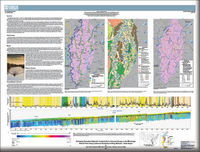Estimating Streambed Hydraulic Conductivity for Selected Streams in the Mississippi Alluvial Plain Using Continuous Resistivity Profiling Methods—Delta Region
Links
- Sheets:
- Data Release: USGS—Waterborne resistivity inverted models, Mississippi Alluvial Plain, 2016–2018
- Download citation as: RIS | Dublin Core
Introduction
The Mississippi Alluvial Plain is one of the most important agricultural regions in the United States, and crop productivity relies on groundwater irrigation from an aquifer system whose full capacity is unknown. Groundwater withdrawals from the Mississippi River Valley alluvial aquifer have resulted in substantial groundwater-level declines and reductions in base flow in streams within the Mississippi Alluvial Plain. These effects are limiting well production and threatening future water availability in the region.
A comprehensive assessment of water availability in the Mississippi Alluvial Plain is critically important for making well-informed management decisions about sustainability, establishing best practices for water use, and predicting changes to water levels in the Mississippi Alluvial Plain over the next 50–100 years. The first step in the new regional modeling effort was to run the existing Mississippi Embayment Regional Aquifer Study (MERAS) model and perform data-worth and uncertainty analyses to prioritize data collection efforts to improve model forecasts. Parameter estimation indicated that streambed conductance was one of the variables that the model was most sensitive to, but little data were available to constrain those general estimates.
From this characterization of the existing data, a map of the streams that the MERAS model was most sensitive to was created by the U.S. Geological Survey to guide the collection of 862 kilometers of waterborne resistivity surveys within the Delta region of Mississippi to characterize streambed lithology. This technique characterizes the streambed itself and the 15–30 meters below the streambed that control the exchange of water between the stream and the alluvial aquifer. These data can be used to map changes in the lithology of the streambed and identify areas of potential groundwater/surface-water exchange. Additionally, electrical and nuclear well logs from the study area were compared to facilitate the development of a petrophysical relation between the waterborne resistivity data and hydraulic conductivity. Resistivity values may then be used as a cost-effective way to approximate aquifer hydraulic conductivity distributions for use in regional groundwater models.
Suggested Citation
Adams, R.F., Miller, B.V., Kress, W.H., Minsley, B.J., and Rigby, J.R., 2023, Estimating streambed hydraulic conductivity for selected streams in the Mississippi Alluvial Plain using continuous resistivity profiling methods—Delta region: U.S. Geological Survey Scientific Investigations Map 3500, 2 sheets, https://doi.org/10.3133/sim3500.
ISSN: 2329-132X (online)
Study Area
Table of Contents
- Introduction
- Surficial Geology
- Methods
- Waterborne Resistivity
- Estimated Hydraulic Conductivity
- Figure Annotations
- References Cited
| Publication type | Report |
|---|---|
| Publication Subtype | USGS Numbered Series |
| Title | Estimating streambed hydraulic conductivity for selected streams in the Mississippi Alluvial Plain using continuous resistivity profiling methods—Delta region |
| Series title | Scientific Investigations Map |
| Series number | 3500 |
| DOI | 10.3133/sim3500 |
| Publication Date | August 03, 2023 |
| Year Published | 2023 |
| Language | English |
| Publisher | U.S. Geological Survey |
| Publisher location | Reston, VA |
| Contributing office(s) | Lower Mississippi-Gulf Water Science Center |
| Description | 2 Sheets: 45.00 x 34.25 inches and 45.00 x 34.55 inches |
| Country | United States |
| State | Arkansas, Louisiana, Mississippi |
| Other Geospatial | Mississippi Alluvial Plain |
| Online Only (Y/N) | Y |


